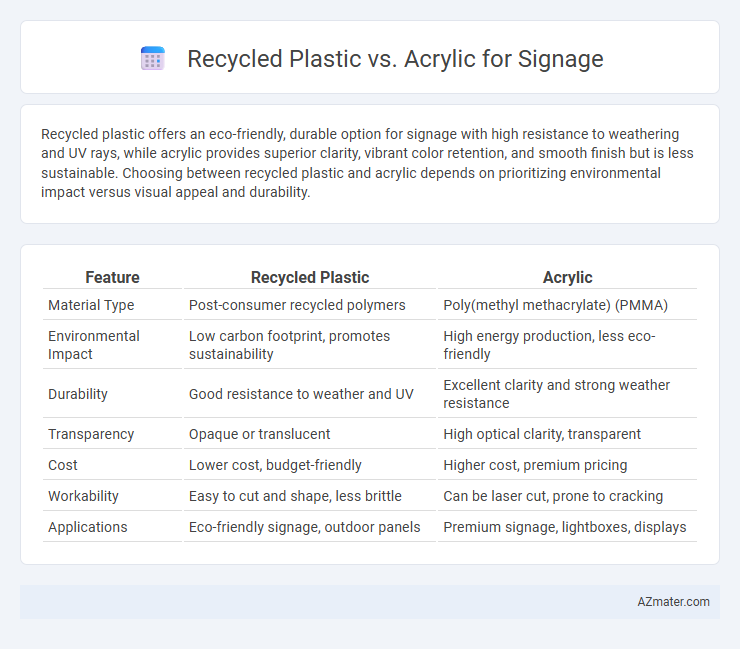Recycled plastic offers an eco-friendly, durable option for signage with high resistance to weathering and UV rays, while acrylic provides superior clarity, vibrant color retention, and smooth finish but is less sustainable. Choosing between recycled plastic and acrylic depends on prioritizing environmental impact versus visual appeal and durability.
Table of Comparison
| Feature | Recycled Plastic | Acrylic |
|---|---|---|
| Material Type | Post-consumer recycled polymers | Poly(methyl methacrylate) (PMMA) |
| Environmental Impact | Low carbon footprint, promotes sustainability | High energy production, less eco-friendly |
| Durability | Good resistance to weather and UV | Excellent clarity and strong weather resistance |
| Transparency | Opaque or translucent | High optical clarity, transparent |
| Cost | Lower cost, budget-friendly | Higher cost, premium pricing |
| Workability | Easy to cut and shape, less brittle | Can be laser cut, prone to cracking |
| Applications | Eco-friendly signage, outdoor panels | Premium signage, lightboxes, displays |
Introduction to Recycled Plastic and Acrylic Signage
Recycled plastic signage offers an eco-friendly alternative by utilizing post-consumer or post-industrial plastic waste, reducing environmental impact and conserving natural resources. Acrylic signage, made from polymethyl methacrylate (PMMA), provides a high-gloss, durable surface with excellent clarity and weather resistance, ideal for long-lasting visual displays. Both materials cater to distinct needs in signage, with recycled plastic emphasizing sustainability and acrylic focusing on premium aesthetics and durability.
Material Composition: Recycled Plastic vs Acrylic
Recycled plastic signage is primarily composed of reclaimed polyethylene or polypropylene, offering an eco-friendly alternative by repurposing post-consumer waste, while acrylic is a synthetic polymer made from polymethyl methacrylate known for its clarity and weather resistance. Recycled plastic materials often exhibit varying textures and are less prone to cracking, but may have limited color vibrancy compared to the highly transparent and smooth surface of acrylic. The choice between recycled plastic and acrylic hinges on balancing sustainability with optical quality and durability specific to signage applications.
Environmental Impact and Sustainability
Recycled plastic significantly reduces waste and lowers carbon emissions compared to acrylic, which is derived from non-renewable petroleum resources and involves energy-intensive production. The use of recycled plastic promotes circular economy principles by repurposing existing materials, thereby minimizing landfill contributions and reducing pollution. Acrylic signage, while durable and lightweight, lacks biodegradability and can persist in the environment for decades, highlighting recycled plastic as the more sustainable choice for eco-conscious businesses.
Durability and Weather Resistance
Recycled plastic offers excellent durability and weather resistance for signage, exhibiting strong resistance to UV rays, moisture, and temperature fluctuations, making it ideal for long-term outdoor use. Acrylic, while providing high clarity and aesthetic appeal, is more prone to cracking and yellowing under prolonged exposure to sunlight and harsh weather conditions. Choosing recycled plastic ensures enhanced longevity and reduced maintenance costs, especially in environments subject to extreme weather variations.
Aesthetic Qualities and Customization Options
Recycled plastic offers a unique, eco-friendly aesthetic with a matte finish and subtle texture variations, making each sign distinct and environmentally conscious. Acrylic provides a sleek, glossy surface with vibrant color options and superior transparency, ideal for modern and high-impact visual appeal. Customization on recycled plastic often includes eco-themed designs and textures, while acrylic allows for precise laser cutting, engraving, and diverse color layering to achieve intricate and polished signage.
Cost Comparison and Budget Considerations
Recycled plastic signage is generally more cost-effective due to lower material and production expenses, making it ideal for budget-conscious projects. Acrylic signs, while offering superior clarity and durability, tend to have higher upfront costs that may impact overall budget allocation. Evaluating long-term maintenance and environmental benefits alongside initial investment helps optimize signage expenses effectively.
Installation and Maintenance Requirements
Recycled plastic signage offers lightweight and flexible installation options, often requiring basic tools and minimal support structures compared to acrylic, which demands precise cutting and specialized mounting hardware to prevent cracking. Maintenance of recycled plastic signs is generally easier due to their resistance to UV rays and weathering, while acrylic signs require regular cleaning with non-abrasive materials and occasional polishing to maintain clarity and prevent yellowing. Both materials provide durability, but recycled plastic's lower maintenance needs and simpler installation make it ideal for cost-effective and environmentally conscious signage projects.
Applications: Suitable Uses for Each Material
Recycled plastic is ideal for outdoor and environmentally conscious signage applications such as directional signs, outdoor displays, and promotional boards due to its durability, weather resistance, and eco-friendly properties. Acrylic is preferred for high-end indoor signage, illuminated displays, and retail branding because of its superior clarity, smooth finish, and ease of customization with engraving or printing. Both materials offer versatile solutions, with recycled plastic excelling in sustainability-focused projects and acrylic providing a premium aesthetic for professional visual communication.
Safety and Health Considerations
Recycled plastic for signage offers significant environmental benefits but may contain impurities or additives that could release harmful chemicals during fabrication or exposure to heat, posing health risks if proper ventilation and protective measures are not used. Acrylic is generally safer for indoor signage applications due to its stable composition and low toxicity; however, it can emit fumes when cut or heated that require adequate ventilation to prevent respiratory irritation. Choosing materials with certified low emissions and implementing appropriate safety protocols during installation and maintenance ensures healthier environments for both workers and the public.
Future Trends in Signage Materials
Recycled plastic is gaining traction in signage due to its environmental benefits, durability, and cost-effectiveness, making it a sustainable alternative to traditional materials. Acrylic remains popular for its clarity, versatility, and high-quality finish but is increasingly supplemented or replaced by eco-friendly options like recycled polymers. Future trends in signage materials emphasize sustainability, with innovations in bio-based plastics and enhanced recyclability shaping the industry's shift towards greener solutions.

Infographic: Recycled plastic vs Acrylic for Signage
 azmater.com
azmater.com